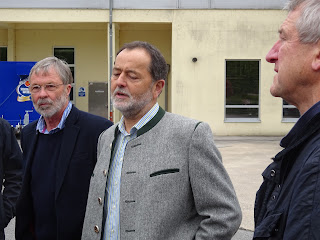Production grew in the 70s and 80s and they now make around 250k hl (150k bbl) of wheat beer a year.
 |
| Old wort cooler |
The grist is 60% wheat malt and 40% barley malt. Colour for the Original is 16 EBC. Malt and hops are sourced locally but as no strains of wheat have been bred for brewing they have to try and get the best they can. Ideally 12% protein but recently they have had to use 13.5-14%. A small amount of black malt (0.5%) is used for colour.
They use city water (which has 20 German degrees of hardness). Ultra filtration and reverse osmosis are used to purify and de-mineralise it and calcium chloride is added to the brewing liquor. A Lactobacillus fermentation (at 28°C) allows them to add acid whilst still sticking to the letter of the reinheitsgebot. Mash pH is 5.4 to 5.5 and lactic addition drops the pH in the copper to 5.2 to 5.3 which drops to 5.1 to 5.2 by the end of the boil.
They have open fermenters and as you might expect from a wheat beer brewery the fermentation room smelt of bananas!
The Original has 14 IBUs of bitterness. The bittering hop is Herkules, with Hallertau tradition added 10-15 minutes from the end of the boil. Saphir is used as a dry hop in the hopfenweis at 1.2kg/hl. Hallertau Cascade is used in Kristal and Tap 1 (pale weiss). One brew goes in each fermenting vessel and they brew six times a day.
Fermentation takes five to seven days (at 17°-22°C), except for the alcohol free beer which has three to four days. A 10°P Speis (food) is brewed once a week for use as priming in the bottle conditioned beers.
 |
| Lid with spray ball for Cleaning In Place |
Bottle conditioning is carried out for a minimum of two weeks at 15°C. The final gravity is 2°P. The beer is centrifuged on its way to the Conditioning Tank (10% bypassed) and speis (10%) is added on the way.
They were kind enough to make a diagram in English explaining how the bottling line works. As they have reusable bottles there's a lot going on!
The it was a stop for some lunch...
...followed by the tasting. I wasn't really looking forward to this bit, expecting to be served thimblefuls of various beers whilst someone lectured us on the likes of 4-vinyl guaiacol and isoamyl acetate. Instead we were taken to a cellar in which various crates of beer were laid out and basically told "fill your boots". So we did. Superb!













Any evidence of flash pasteurization or otherwise for haze stability?
ReplyDeleteGerman brewers are a shifty bunch, but I think they're playing it straight at Schneider Weisse.
Delete